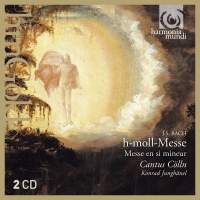Texte paru dans: / Appeared in: |
|
|
Outil de traduction ) |
|
|
|
|
|
Reviewer: Brian
Robins
Meanwhile we have Cantus Cölln
with a performance that follows Parrott in taking an approach that might be
called modified minimalism. While the performance is essentially
one-per-part, many of the bigger choruses employ the reinforcement of a
second singer, or ripienist, to each part, although Junghänel and Parrott do
not always concur as to which movements require the addition. Junghänel’s
most surprising omission of ripienists is perhaps in the Sanctus, where they
are employed by Parrott. Neither does the German conductor use his
ripienists in the true sense of the word, since the fact that Cantus Cölln’s
ensemble consists entirely of soloists means that solos are spread around
democratically. It is rather a pity that Peter Wollny’s good note gives no
indication as to the ethos behind the performance, it being left only to the
blurb on the back of the box to tell us that it “should not be seen as a
dogmatic position . . . but as an alternative style of interpretation.”
Having found myself much out
of kilter with critical opinion on Cantus Cölln’s disc of Bach cantatas,
which—largely due to excessively fast tempos—I thought essentially
superficial, my approach to their recording of the Mass was not without a
certain apprehension. On the whole, the tempo question is not such a problem
here, although there are still places (Kyrie II, where the deliberately
archaic setting is rather robbed of its effect, the opening of the Gloria,
and the “Cum sancto” fugue at the end of the Gloria) where steadier speeds
might have paid dividends so far as contrapuntal and textural clarity are
concerned. Conversely, Agnus Dei is taken rather slowly, disrupting the
natural flow and causing Elisabeth Popien problems of maintaining pitch in
Bach’s cruelly sustained long paragraphs. No, the real problems here lie in matters other than tempo, and it’s not that easy to put a finger on them. As they have proved on many occasions, Cantus Cölln is one of the most thoroughly professional and accomplished small vocal ensembles around. To that they can add, when required, an outstanding chamber orchestra, as is the case here. The exquisite limpidity of the flute solo in “Dominus Dei” will serve as an example of the many instances of outstanding obbligato playing. It therefore goes without saying that from an executant angle, the performance meets the demanding standards of the Mass with little difficulty. Certainly, there are vocal solos one has heard better sung elsewhere—I don’t care much for the grey, featureless “Et in inspiritum” bass solo (Credo)—but in general terms they are done with considerable accomplishment, and often, as in Kyrie II, entrancingly sung by Susanne Rydén and Johanna Koslowsky, with a great deal more than that.
Where I think the performance
does fail is in its unexpected lack of fervor or, indeed, real involvement—a
serious flaw in a work that stands as one of the most monumental professions
of faith in the repertoire. One can sense this in the opening Kyrie, where,
after an impressively broad opening statement, the orchestral introduction
to the huge, extended fugue seems lacking in portent for what is to come, an
impression only enhanced when the voices enter. There is little sense of an
overall design to the movement, no impression of a monumental edifice being
built. Similarly, despite the fast tempo, the opening of the Gloria lacks
conviction, as does the opening of the Credo, for all the urgency of the
running bass quarter notes. Again, there is little to overwhelm the senses
in the great cries of Sanctus, no notion of the soprano lines slowly
drifting heavenwards as there is with Parrott. There are, of course, times
when the performance does succeed in conveying a greater sense of
conviction, most notably at “Et incarnatus” (Credo), where the rapt,
awe-struck placidity combines with Bach’s painfully sweet dissonant
harmonies to create a few rare moments of interiority. Sadly, it is
dispelled by a “Crucifixus” marred by the mannered over-stressing of the
first three syllables of that word, one of several instances of eccentricity
that include disruptive, jerky rhythms at “in remissionem” (Credo), and
“pleni sunt coeli” (Sanctus).
Glancing back at what I have
written, I’ve possibly accentuated criticism at the expense of other good
things, of which there are certainly more deserving of mention. Yet,
ultimately, there is no escaping the fact that this a disappointing
recording that fails to match the greater conviction and spirit of the
Parrott reading, the closest rival to this style of performance. That,
however, is now only available in a Bach compendium that includes several
less satisfactory performances (26:5), so anyone still holding fire on a
“minimalist” B-Minor Mass is advised to wait in the hope of a McCreesh.
Those with a preference for a standard choral version have, of course, a
greater choice that includes both Herreweghe readings (Virgin and HM) and
Fasolis (Arts) among the front-runners for a period performance. | |
|
|
|
|
|
|
|
Cliquez l'un ou l'autre
bouton pour découvrir bien d'autres critiques de CD |
|




